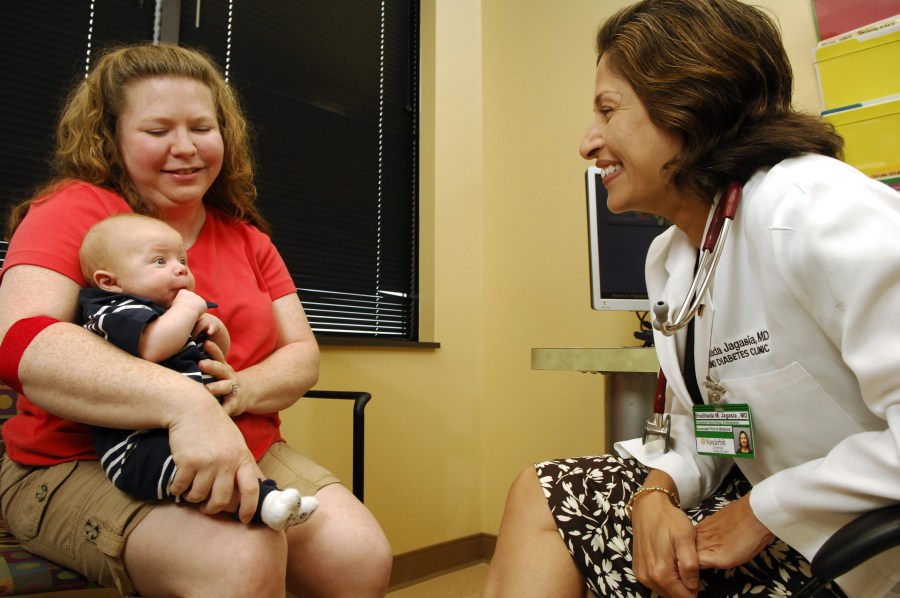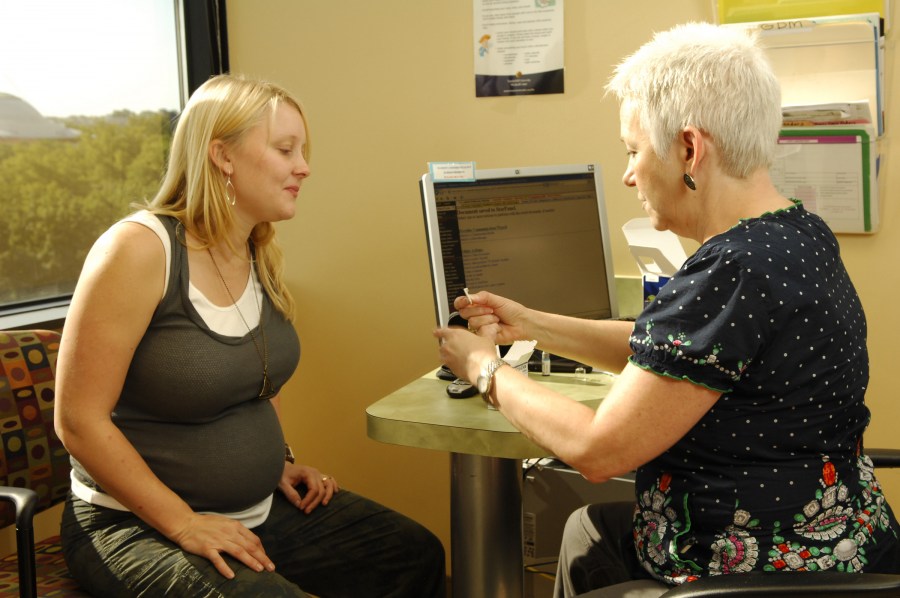
Gestational diabetes patient Julie Schwaiger holds her son, Luke, during a recent clinic appointment with Shubhada Jagasia, M.D. (photo by Anne Rayner)
Gestational diabetes program goal is healthy babies, moms
Baby Luke has a very serious face that suddenly breaks into a wide grin as he bounces on his mother’s knee.
Luke is Julie Schwaiger’s fourth son, but her first with gestational diabetes, a condition associated with elevated blood sugar first diagnosed during pregnancy. Schwaiger worked hard to watch her diet and exercised regularly to keep her blood sugar normal while she was pregnant.
After Luke was born June 17 at 6 lbs., 9 oz., Schwaiger said she recovered faster and felt better compared to her other deliveries.
This completely normal birth, with a healthy baby and mother, is exactly what Vanderbilt University Medical Center’s Gestational Diabetes Program is all about.
All pregnant women are screened for gestational diabetes mellitus (GDM) at 24-28 weeks of pregnancy, and those who fail the test are referred to Vanderbilt’s gestational diabetes clinic, headed by Shubhada Jagasia, M.D., associate professor of Medicine.
“Gestational diabetes unmasks a woman’s latent genetic tendency toward diabetes, at a time when weight gain of pregnancy and placental steroid hormones are both decreasing her body’s sensitivity to the amount of insulin she is able to secrete,” Jagasia said.
On average, the incidence of GDM in the United States is 7 percent to 14 percent, but can be as high as 25 percent in minority populations more predisposed to diabetes.
The biggest risk for a woman with GDM is preeclampsia, a life-threatening condition of high blood pressure during pregnancy. The baby’s main risk is a higher weight, which can complicate vaginal birth or necessitate a cesarean section.
Following birth, babies are at increased risk of low blood sugar, low calcium, jaundice or respiratory distress, and may need to be treated in the Neonatal Intensive Care Unit.
“We’re also learning that gestational diabetes truly impacts a baby’s long-term health. Heavier birth weight tends to increase the babies’ risk of adolescent and adult obesity and metabolic complications associated with that. We feel that they may be programmed for future diabetes in the womb,” Jagasia said.
Women with GDM also have a higher risk of developing diabetes later in life, with up to 50 percent developing type 2 diabetes within 10 years.
That statistic is startling to Sarah Rose, who is due Oct. 8 with her first child and has just been diagnosed with GDM.

Patricia Patterson, R.N., CDE, right, teaches gestational diabetes patient Sarah Rose how to use a glucometer to monitor her blood sugar. (photo by Anne Rayner)
“It’s shocking to hear that percentage, but it’s good to know what can happen to me later while I still have time to change it,” Rose said.
Like any new patient, Rose first saw clinic nurse Patricia Patterson, R.N., CDE, who reviewed her health history, diet and exercise and taught her to use a glucometer to test her blood sugar.
All patients keep a weekly record of their blood sugar levels and report them on Monday mornings by fax, phone or the My Health at Vanderbilt website. Most patients can keep GDM under control with diet and exercise, but some require medication or insulin injections.
New patients also see dietitian Jennifer Garland, MPH, R.D., CDE, to discuss nutrition, something that can be especially tricky with pregnant women. Mothers must ensure their baby gets the proper nutrients while maintaining an optimal weight. There are also cravings, morning sickness and baby shower cakes to contend with.
Jagasia started the clinic in 2002 because she knew there was an opportunity to make a big impact.
“GDM is a red flag. It’s a cardinal event in a woman’s medical history where she is given a warning of things to come 10-15 years down the road,” Jagasia said. “These women are diagnosed at a time when they’re motivated and want to take control of their health.”
Julie Isbell, BSN, R.N., heeded that red flag in a big way, losing 120 pounds after a GDM diagnosis with her second son.
“It was like a slap in the face for me and I knew I needed to turn myself around,” said Isbell, interim director of the integrated service line for the Center for Childhood Cancers and Blood Disorders at the Monroe Carell Jr. Children's Hospital at Vanderbilt.
With the help of the gestational diabetes clinic, Isbell began walking five to six days a week, strictly monitored her diet and found success with the accountability of reporting her blood sugar levels each week.
“I knew that if I didn’t eat right and control my intake, somebody else was going to see that and it was going to affect my baby. How could I do something so stupid to potentially harm him?”
Bryce was born Nov. 20 at 9 lbs. with normal blood sugars. When Isbell returned to work after maternity leave, some colleagues didn’t recognize her.
“Without the clinic I think I probably would still be floundering around, obese and wishing I was skinny, like I had been my entire life,” she said.
The clinic has received recognition from the American Diabetes Association, a rarity for one that focuses on gestational diabetes.
The recognition means the clinic meets national standards of care and is committed to quality improvement initiatives. This has fostered inter-departmental research to study the impact of earlier GDM testing during pregnancy, called the Diabetes: Prevention for Life initiative.
“Gestational diabetes has a lifelong impact on both mother and child. I tell patients not to look at this as a condition affecting a few weeks of pregnancy, but one that will affect their long-term health over the next several years, and to focus on what we can do together to reverse that,” Jagasia said.













